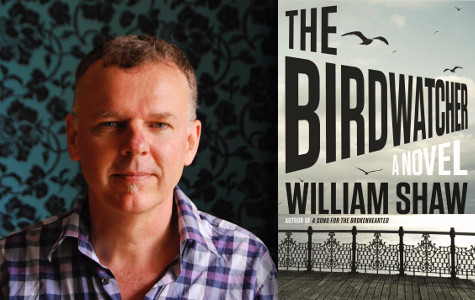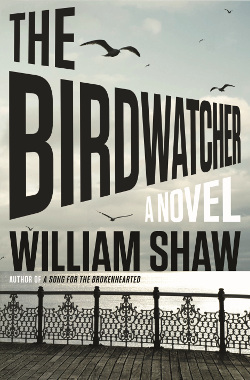
William Shaw is a novelist and award-winning pop culture journalist. He has regularly written for the UK’s Observer and Independent as well as the New York Times. Mr. Shaw’s books include the series titles She’s Leaving Home, The Kings of London, and A Song for the Brokenhearted. His newest, The Birdwatcher (available June 27, 2017), is a standalone published by Mulholland Books.
Recently, the Sussex, England-based author generously indulged a few curiosities about branching out from series books, creating complex characters, learning the nuances of birdwatching, and the differences between British and American crime novels, among other topics.

What was the impetus for writing The Birdwatcher, and why did a standalone appeal to you as opposed to a continuation of your series?
All writers I know are restless and want to try different angles. I’d done three books set in the 1960s—the series that started with She’s Leaving Home. In a series, you deliberately leave threads hanging that you can pick up elsewhere. I wanted to do something where threads all come together in one book—partly to see if I could. And no one was more surprised when all they came together than me.
Police Sergeant William South has operated on both sides of the law. How do his imperfections serve the story, and what challenges come in endeavoring to balance likability with realism when fleshing out your characters?
There was this guy I spent some time with in 1996; I’m pretty sure from the way he talked about what he’d done a few years earlier that he had killed someone. The thing was, he didn’t actually admit it. He’d shot a guy, yes. But he would never say he had actually killed him.
I used to be a journalist. Back in the 90s, I spent quite a lot of time in South Central LA talking to young men like him, many of whom had been deeply involved in gangs. Detection rates were terrible, so it struck me that it was likely that at least one of them had murdered someone and gotten away with it—possibly this shy, quiet-spoken guy.
The terrible truth is that killing someone doesn’t automatically make you a monster; most murders are simply seconds of madness in an otherwise ordinary life. What I find interesting about the act of murder is the question of how killers can live with themselves. So I wanted a protagonist who was a good person but also someone we knew had been a killer. So right at the start, I tell readers that William South is a killer, but I also show that he’s a decent man. I hope that’s the conundrum that pulls the reader in.
South is an avid birdwatcher. How does this hobby compliment his powers of detection, and in what ways is it reflective of the overall story arc?
I love to write books where I have to learn stuff as I write, and I had to learn about birds to get that right. Actually, I was far more terrified of getting the birdwatching detail right than the minutiae of policing, because birders have spent years learning this stuff, and it’s important to them. Birders are patient people who watch for days just to see something tiny, far away. Collectively, they have built up this amazing body of scientific knowledge.
The terrible truth is that killing someone doesn’t automatically make you a monster; most murders are simply seconds of madness in an otherwise ordinary life.
Patient observation and the ability to carefully put facts together are perfect skills for a quiet copper like William South. But it also pulls him into the orbit of the woman who he fears is going to be his nemesis, Detective Sergeant Alex Cupidi, because her daughter becomes obsessed with birds. When I’d done the first draft, I gave it to birders to let them tear it apart; they were universally kind and generous and corrected all my many mistakes.
You use a small town on the Kentish coast as a backdrop. In your opinion, how does setting enhance narrative, and in what ways can atmosphere act as its own character within a story?
I think part of why we read is to visit extraordinary places, so simply setting a book in an extraordinary place—and Dungeness is one of those—ticks that box. Some characters can be defined by landscape, and Dungeness always felt like one of those places people would go to hide. It’s an awesome place with big skies and dangerous tides, but it’s not pretty by any means. I started with the place and thought, “What kind of people would come here and what would they be hiding from?”
What do you find to be the greatest differences between British and American crime novels, and how might exposure to one influence readers’ (or writers’) appreciation of the other?
American crime novels have a kind of style and wit that British ones rarely achieve, from Raymond Chandler through to Jim Thompson, Robert B. Parker, and Joe R. Lansdale. The other big difference is in American notions of masculinity. You Americans have such a gloriously romantic vision of masculinity, with your craggy, hard-bitten outsiders always on the edge of social norms. The modern British man is a much more prosaic hero; the fun for us is how to make such ordinary men appear heroic. I suspect that American and British cultures have drifted apart in my lifetime, though, which is a shame. Speaking as a prosaic Englishman, I’d say that cross-pollination is always good.
Leave us with a teaser: What comes next?
So The Birdwatcher has two police officers in it, Sergeant William South and Detective Sergeant Alexandra Cupidi. What if the woman were to have her own series set in the same part of Kent? The book will be called Salt Lane; working on the second draft now.
To learn more or order a copy, visit:
opens in a new window![]() opens in a new window
opens in a new window![]()
William Shaw is an award-winning pop culture journalist, who has written regularly for the UK's Observer and Independent, as well as the New York Times. His previous novels are She's Leaving Home, The Kings of London, and A Song for the Brokenhearted. Shaw lives in Sussex, England.
John Valeri wrote the popular Hartford Books Examiner column for Examiner.com from 2009 – 2016. He can be found online at www.johnbvaleri.com and is featured in the Halloween-themed anthology Tricks and Treats, now available from Books & Boos Press.
